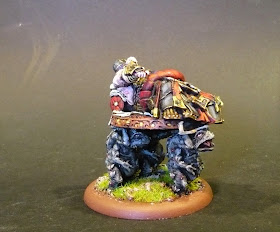I've been slowly making my way through Jon Peterson's magnificent Playing at the World, a deep and scholarly (yet readable) account of the origins of role-playing games that goes all the way back to 18th-century chess variants and the emergence of genre literature and then traces things up through to the publication of the original boxed set of Dungeons & Dragons. It's a gaming nerd's dream, frankly.
One thing I've been taking away from my readings so far (I'm about halfway through) is that the more things change, the more they stay the same. Back during the whole "Consultancygate" brouhaha in July, for example, I just happened to be reading a section that touched on some of the infighting in the nascent gaming community following the publication of D&D, wherein two camps emerged, divided between the old guard wargamers and the more counterculture-inspired RPGers, both of whom claimed the other was "doing it wrong" and that they themselves had the moral high ground. It was certainly illustrative of the fact that the gaming community has always been subject to passionate debates on perceptions of who or what should and shouldn't be allowed in the hobby.
More recently, of course, there's been a much more widely-reported controversy surrounding the acceptance (or lack thereof) of women in the larger video-gaming community. I'm not a video gamer by any stretch of the imagination, but over the years I've witnessed similar prejudices being expressed in the RPG hobby as well. Once again, Playing at the World has provided an interesting and timely point-of-view.
In my latest reading, the book is discussing a game called Fletcher Pratt's Naval War Game. Published in 1943, the game was developed from soirees Pratt (a pulp fiction writer) would hold at his Manhattan apartment (and later, when attendance got up to around 50 people, at a nearby hall) in which attendees would engage in a wargame featuring model ships, played out using the floor as the game space.
The game was significant to the later development of RPGs because it influenced the development of mechanics like Armor Class and Hit Points. But it was also significant for being the first time female gamers got a mention in a published wargame, previously perceived as the exclusive domain of men. Quoted from the rulebook itself:
"[Once Pratt's group had embraced the system] the sweethearts-and-wives influence became manifest. One of the latter appeared as a spectator of what was originally intended to be a purely stag game. In the midst of the ensuing red-hot engagement she was discovered flat on her stomach, aiming the guns of a cruiser and muttering something like, 'I'll get the so-and-so this time.' From that date on there was no checking the rising tide of feminism. Today there are nearly as many players of one sex as of the other; and one of the feminine delegation has been praised by a naval officer as the most competent tactician of the group."
Playing at the World goes on to feature an illustration from the book in which "a skirted woman, alongside her male counterparts, is shown kneeling on the floor, angling a cardboard arrow to fire at her target."
It also discusses how this inclusion represented an evolution from H.G. Wells' Little Wars (1911), the first wargame marketed to casual gamers; although the book subtitles itself as a "game for boys from twelve years of age to one hundred and fifty and for that more intelligent sort of girl who likes boys' games and books", Wells also complains within the pages of his rules of being interrupted "by a great rustle and chattering of lady visitors" who "regarded the [game] with the empty disdain of their sex for all imaginative things."
In my 25-plus years of tabletop gaming, I've gamed with at least as many women as men. My current weekly face-to-face group is comprised of a majority of women, and has been all-woman (save for yours truly) at times in the past. I've also gamed with women who were flat-out denied the opportunity to join other groups because of their gender.
I've written about this before, but I just want to reiterate that, of the women I've gamed with, some have sucked at math and others have loved crunch; some have been totally story-oriented and others have been violent and bloodthirsty. In other words, they've been just like all the male gamers I've played with.
I wanted to post this little piece of history simply because it shows that women's interest in the tradition of gaming from which RPGs, wargaming, and video games grew out of goes back a long ways. If this sort of history was better-known...well, we'd still probably have lots of stupid trolls out there spewing misogyny in-person and online, but knowing about stuff like this puts their ridiculous appeals to the "tradition" of an all-male hobby in an even weaker light, I think.

.JPG)









